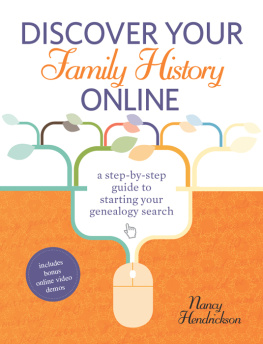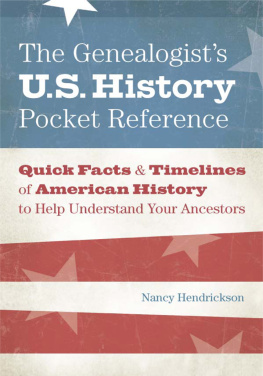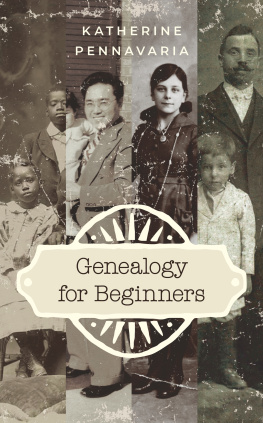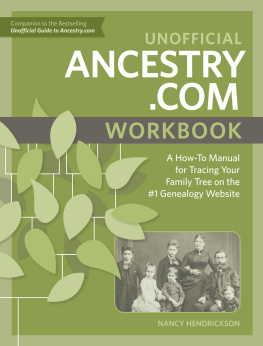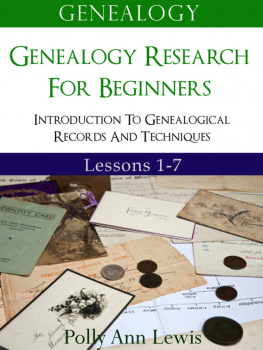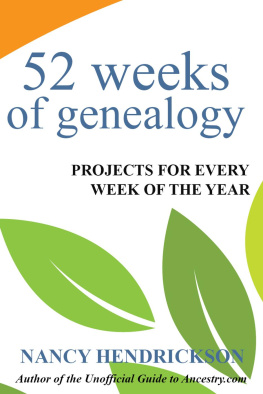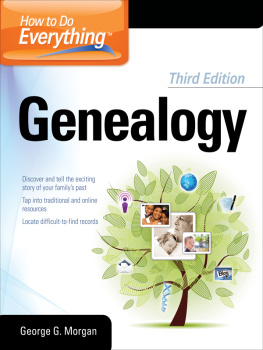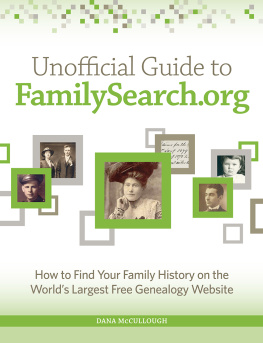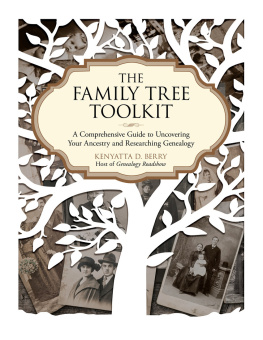Contents
Guide
UNOFFICIAL
GUIDE TO
ANCESTRY.COM
How to Find Your Family History
on the #1 Genealogy Website
NANCY HENDRICKSON

Cincinnati, Ohio
shopfamilytree.com
CONTENTS
In this chapter youll get an overview of Ancestry.coms layout, memberships, and major content areas, plus learn how to start your genealogy research.
Learn how to create and manage your family tree and search for other family trees.
The chapter youve been waiting fortips for searching the thousands of databases and billions of names on Ancestry.com.
Well explore how you can use this often-overlooked search tool to search collections and individual databases on Ancestry.com.
Censuses are a valuable genealogy research tool. Learn how to find and search census records and voter lists on Ancestry.com.
Records that document life events are the building blocks of genealogy research. Learn how to find and search for vital records on Ancestry.com.
In this chapter well explore Ancestry.coms American military collections and databases as well as available international records.
Discover immigration records available on Ancestry.com, plus learn about ports of entry and tricks for searching the records.
In this chapter youll learn about Ancestry.coms collection of newspapers, publications, and maps and how best to use them in your research.
In this chapter well explore Ancestry.coms Stories, Memories, and Histories collection. As you use the search tips, perhaps youll find at least one mention of your family or the places they lived.
Finding an ancestral photo is like discovering a gateway to who we really are. In this chapter, get an overview of this unique collection, learn about finding images uploaded by other users, and more.
Ancestry.com currently has 4,566 databases in its Schools, Directories, and Church Histories collection, with millions of records. In this chapter youll learn about the five main record groups, what they contain, how best to search them, and what you can expect to find.
In this chapter learn how to use tax, criminal, and land records, as well as wills, to learn more about who your ancestor was and how he conducted his daily life. Plus, get tips for finding these records on Ancestry.com.
Discover how genetic genealogy may aid your research, and learn about AncestryDNA and reviewing your DNA test results on Ancestry.com.
In this chapter well examine collaboration opportunities with other Ancestry.com members and how others can help you with your research.
DEDICATION
This book is dedicated to Colene and Willy, who provided the Paradise in which it could be written.
INTRODUCTION
Like most genealogy geeks, I started my family tree research at the local library and through interviews with family members. Later, I branched out to requesting military records through the National Archives. Back then, online genealogy pickings were slim, save for a few basic sites and mailing lists. Even Ancestry.com , in its infancy, had a tiny sliver of records compared to todays more than fourteen billion records.
Family researchers who subscribe to Ancestry.comwhether beginners or old handshave the opportunity to fill in the missing pieces of their own family history. From the wildly popular United States and United Kingdom census records to obscure databases like the court records of Micronesia, there really is something for everyone.
If youre just getting started in Internet genealogy, this book will guide you through setting up your first family tree and the basics of doing your first Ancestry.com searches. If you already have an Ancestry.com subscription and have had some level of success, youll discover how to use advanced search techniques to track down some of your more elusive ancestors.
In writing this book, Ive added many records to my own family tree along with unexpected finds like my dads high school yearbook picture and the transcription of my great-great-great-grandfathers will. The amount of material available at Ancestry.com is mind-boggling and the potential for finding your family is almost limitless.
As you read each chapter, youll find real-life searches that you can duplicate on your own computer. Hopefully each example will show you how to use your detective skills to find the database that contains your familys history. And dont be surprised if you find another researcher whos already unearthed the exact piece of information thats stymied you for years.
Please get in touch with your own success stories. I always love hearing how the books tips and techniques helped you uncover the hidden past. You can contact me at .
Nancy Hendrickson
San Diego, California
@genealogyteach on Twitter
GETTING STARTED WITH
ANCESTRY.COM
Everyone has his or her own reasons for climbing the family tree. For some, it may provide the proof needed to join a lineage society like the Daughters of the American Revolution. But for others, it may be a case of simple curiosity: Who came before me? What did they do? And how am I like them?
Back in the day, finding out anything about your familys place in history required a visit to a national archive, state or local government office, or a family history library. Youd spend hours cranking through reels and reels of microfilm, all with the hope (but not the promise) of locating someone in your family tree. Thanks to the Internetand one website in particularall of that has changed.
The revolution-evolution of digital genealogy is nothing less than miraculous. Over the last several years, theres been an explosion of genealogy records online, thanks in part to individuals, organizations, state agencies, societies, and countless volunteers. However, no one has amassed as large of a collection as Ancestry.com . With its fourteen billion records, its now the worlds largest online family history resource. If you want the hope, as well as the promise, of finding your ancestors records, this is the place to startand this is the book to get you started.
This chapter will introduce you to Ancestry.coms many services, membership options, family tree basics, and the Ancestry.com system itself. Even if you already have an Ancestry.com subscription, I encourage you to start with . You never know what tip might take you onto unexplored paths. In later chapters, Ill cover how to maximize your Ancestry.com membership and dig deep into the many types of records available on the site.
THE ANCESTRY.COM NETWORK
One thing that makes Ancestry.com so valuable to genealogists is its exceptionally large network of genealogy-related websites. Some are linked into Ancestry.coms site via the main navigation menu while others are stand-alone entities. Ancestry.coms holdings are:
- AncestryDNA
- Archives.com
- Family Tree Maker
- Find A Grave
- Fold3
- Genealogy.com
- Genline
- Heritage Makers
- Newspapers.com
- ProGenealogists
- RootsWeb
- Shoebox (formerly 1000memories.com)
For detailed descriptions of these Ancestry.com-owned websites, see .
MEMBERSHIPS
Membership to Ancestry.com provides you access to numerous collections and databases where you can access census, vital, military, and immigration records, as well as other members online family trees.



